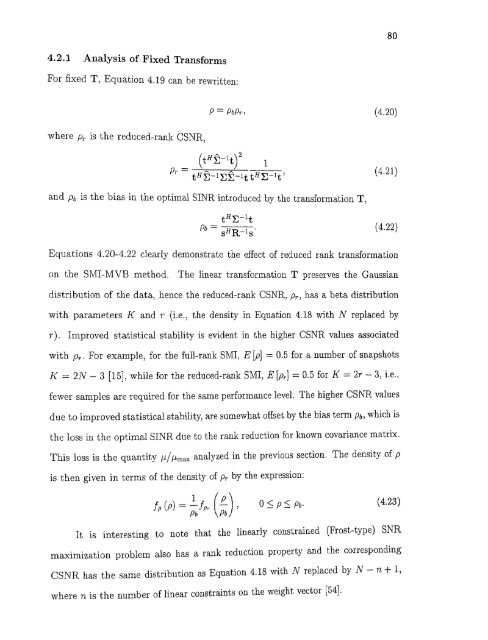Space/time/frequency methods in adaptive radar - New Jersey ...
Space/time/frequency methods in adaptive radar - New Jersey ...
Space/time/frequency methods in adaptive radar - New Jersey ...
You also want an ePaper? Increase the reach of your titles
YUMPU automatically turns print PDFs into web optimized ePapers that Google loves.
804.2.1 Analysis of Fixed TransformsFor fixed T, Equation 4.19 can be rewritten:where pr is the reduced-rank CSNR,and Pb is the bias <strong>in</strong> the optimal SINR <strong>in</strong>troduced by the transformation T,Equations 4.20-4.22 clearly demonstrate the effect of reduced rank transformationon the SMI-MVB method. The l<strong>in</strong>ear transformation T preserves the Gaussiandistribution of the data, hence the reduced-rank CSNR, Pr, has a beta distributionwith parameters K and r (i.e., the density <strong>in</strong> Equation 4.18 with N replaced byr). Improved statistical stability is evident <strong>in</strong> the higher CSNR values associatedwith Pr. For example, for the full-rank SMI, E [p] = 0.5 for a number of snapshotsK = 2N — 3 [15], while for the reduced-rank SMI, E [Pr] = 0.5 for K = 2r — 3, i.e.,fewer samples are required for the same performance level. The higher CSNR valuesdue to improved statistical stability, are somewhat offset by the bias term ph , which isthe loss <strong>in</strong> the optimal SINR due to the rank reduction for known covariance matrix.This loss is the quantity µ/µmax analyzed <strong>in</strong> the previous section. The density of pis th<strong>in</strong> 171v11 <strong>in</strong> terms of the density of Pr by the expression:It is <strong>in</strong>terest<strong>in</strong>g to note that the l<strong>in</strong>early constra<strong>in</strong>ed (Frost-type) SNRmaximization problem also has a rank reduction property and the correspond<strong>in</strong>gCSNR has the same distribution as Equation 4.18 with N replaced by N n 1,where n is the number of l<strong>in</strong>ear constra<strong>in</strong>ts on the weight vector [54].
















